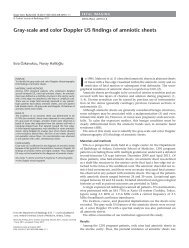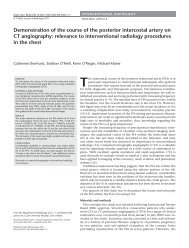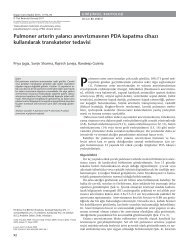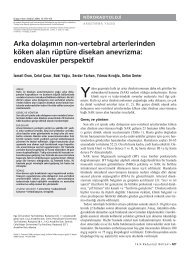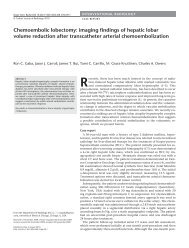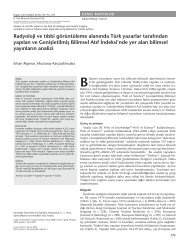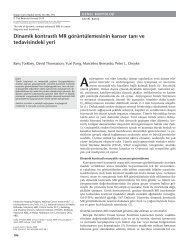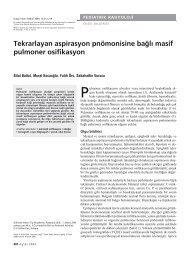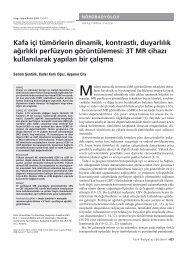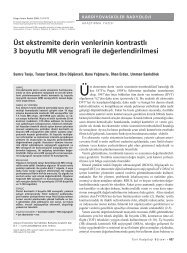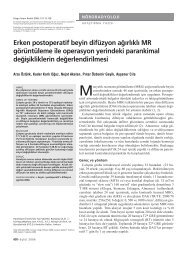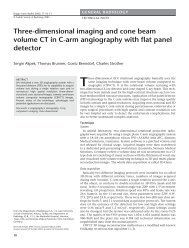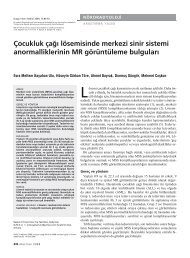Radiological report: expectations of clinicians - Diagnostic and ...
Radiological report: expectations of clinicians - Diagnostic and ...
Radiological report: expectations of clinicians - Diagnostic and ...
You also want an ePaper? Increase the reach of your titles
YUMPU automatically turns print PDFs into web optimized ePapers that Google loves.
Table 6. The answers <strong>of</strong> the participants to the 16 th question, according to the type <strong>of</strong> institution<br />
Question 16: How should the images be provided in addition the <strong>report</strong> (CD, DVD, negative film)?<br />
Answers: a. In CD or DVD format.<br />
b. Printing the full examination on negative films (not important to be economical).<br />
c. a+b (the most expensive preference).<br />
d. Only the pathologic lesions should be printed on the negative film.<br />
e. Presentation <strong>of</strong> the image is not important if the patient has a sufficient <strong>report</strong>.<br />
Answers University hospital Public hospital<br />
a 52 18<br />
b 20 37<br />
c 15 11<br />
d 3 17<br />
e 10 17<br />
Table 7. The percentages <strong>of</strong> answers to all questions according to the choices given<br />
Questions<br />
1 2 3 4 5 6 7 8 9 10 11 12 13 14 15 16 17 18 19<br />
a 3 3.5 53.5 4 46.5 65 92.5 36 13.5 9.5 28.5 30.5 15 27 58 35 3.5 5.5 35.5<br />
Choices<br />
b 60 33.5 41.5 46 53.5 35 - 37.5 19.5 8.5 15.5 56 28.5 14 27 28.5 32 22.5 64.5<br />
c 29 26 5 11 7.5 26.5 32 11.5 56 13.5 29.5 16.5 2 13 43.5 72<br />
d 3.5 37 - 39 35 70.5 27 42.5 13 10 16.5<br />
e 4.5 13.5 4.5<br />
the 19 th question, two <strong>report</strong> examples<br />
for the same patient were presented;<br />
one was in short form, <strong>and</strong> the other<br />
was a st<strong>and</strong>ardized, detailed <strong>report</strong>. Almost<br />
65% <strong>of</strong> the <strong>clinicians</strong> preferred<br />
the st<strong>and</strong>ardized, detailed <strong>report</strong>. In<br />
both <strong>of</strong> these questions, pathology<br />
was indicated in the same manner.<br />
The only difference was the addition<br />
<strong>of</strong> the normal structures to the <strong>report</strong><br />
or a change in the presentation <strong>of</strong> the<br />
<strong>report</strong>, which included sections for<br />
clinical information, methods, findings<br />
<strong>and</strong> conclusion. When the <strong>report</strong><br />
was evaluated with the results <strong>of</strong> the<br />
three questions, we found that <strong>clinicians</strong><br />
preferred st<strong>and</strong>ardized, detailed<br />
<strong>report</strong>s regardless <strong>of</strong> whether they read<br />
the whole <strong>report</strong>. In a study by Naik<br />
et al. (8) that examined 25 radiologists<br />
<strong>and</strong> 95 <strong>clinicians</strong>, six different <strong>report</strong><br />
samples with three clinical scenarios<br />
were formed similarly to our 18 th <strong>and</strong><br />
19 th questions, <strong>and</strong> participants were<br />
asked which <strong>report</strong> they preferred.<br />
This study also found that most <strong>of</strong> the<br />
participants preferred st<strong>and</strong>ardized, detailed<br />
<strong>report</strong>s.<br />
A series <strong>of</strong> questions was designed<br />
to underst<strong>and</strong> what qualified as a sufficient<br />
<strong>report</strong>. Most <strong>of</strong> the <strong>clinicians</strong><br />
requested a detailed description about<br />
all <strong>of</strong> the features <strong>of</strong> each lesion regardless<br />
<strong>of</strong> the number <strong>of</strong> lesions. In addition,<br />
most <strong>of</strong> the <strong>clinicians</strong> requested<br />
lesion descriptions that indicated the<br />
features that could be commented on<br />
by <strong>clinicians</strong> (e.g., calcification, necrosis,<br />
hemorrhage) rather than the use <strong>of</strong><br />
radiologic terminology. However, this<br />
request was for a diagnosis that is more<br />
appropriately made by a pathologist,<br />
though it was still expected from the<br />
radiologist.<br />
Furthermore, there was no consensus<br />
amongst the <strong>clinicians</strong> about the<br />
format <strong>of</strong> the <strong>report</strong>. Similarly, there<br />
was no consensus about <strong>report</strong>ing the<br />
results <strong>of</strong> normal measures. In a study<br />
by Naik et al. (8), the authors were not<br />
sure about the examination <strong>of</strong> the organ<br />
if it was not noted in the <strong>report</strong>.<br />
However, in the same study, most <strong>of</strong><br />
the participants preferred st<strong>and</strong>ardized,<br />
printed <strong>report</strong>s, which did not agree<br />
with the present findings. In another<br />
study, Gagliardi (3) emphasized the<br />
significance <strong>of</strong> st<strong>and</strong>ardized <strong>report</strong>s.<br />
Similarly, in an evaluation performed<br />
on 104 <strong>clinicians</strong>, Lafortune et al. (9)<br />
concluded that “radiological <strong>report</strong>s<br />
should be explicit, should give direct<br />
answers to clinical questions requested<br />
<strong>and</strong> should contain findings <strong>and</strong> conclusion<br />
sections”.<br />
When the <strong>clinicians</strong> were asked how<br />
they interpreted an uncertain finding<br />
in the radiologist’s <strong>report</strong>, 28% stated<br />
that they considered all uncertain sentences<br />
as positive for pathology. This<br />
finding is very interesting <strong>and</strong> must be<br />
taken seriously. Interpreting all uncertain<br />
sentences as positive for pathology<br />
will affect the treatment <strong>of</strong> the<br />
patient, <strong>and</strong> mistakes that are made<br />
in the comments <strong>of</strong> suspected lesions<br />
may have serious consequences. Only<br />
15.5% <strong>of</strong> the subjects stated that they<br />
might request additional examinations<br />
due to uncertain expressions.<br />
Interestingly, in situations where the<br />
conclusion is not definitive but there<br />
is suspicion <strong>of</strong> a positive pathology, a<br />
recommendation <strong>of</strong> additional examinations<br />
would be an integral part <strong>of</strong><br />
the <strong>report</strong>. Similar to the findings in<br />
the Lafortune et al. study (9), which<br />
found that the radiological <strong>report</strong><br />
should contain conclusion <strong>and</strong> recommendation<br />
sections, the present<br />
study found that a recommendations<br />
section was requested by the majority<br />
<strong>of</strong> the <strong>clinicians</strong>.<br />
184 • September 2010 • <strong>Diagnostic</strong> <strong>and</strong> Interventional Radiology<br />
Doğan et al.



